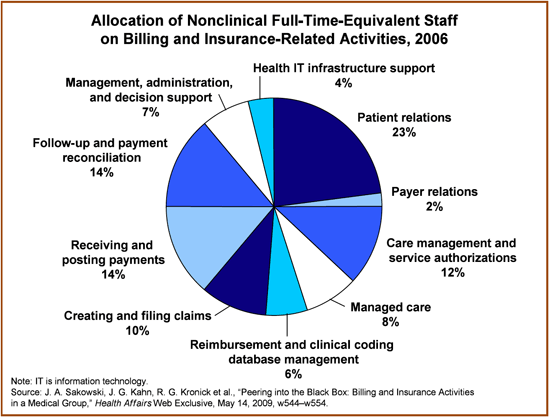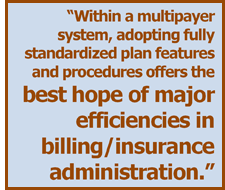Synopsis
A close analysis of the costs of billing and insurance tasks in a large medical group practice found that such tasks consume $85,276 per full-time equivalent physician—or 10 percent of operating revenue. Standardizing health plan benefits and billing procedures would reduce administrative complexity and costs.

The Issue
Health care organizations spend significant resources on the billing and insurance tasks required to secure payment for clinical services. Greater understanding of the time spent on various tasks could inform policy changes intended to simplify health care financing and reduce administrative costs.
Key Findings
- At one large multispecialty medical group, a total of 0.67 nonclinical full-time equivalent (FTE) staff worked on billing and insurance activities for each FTE physician.
- Thirty-eight percent of non-clinical personnel working on billing and insurance activities, or 0.25 full-time employees per full-time physician, were performing tasks related to collecting payment, such as creating and filing claims, processing payments, and claim follow-up and payment reconciliation.
- Physicians reported spending an average of 35 minutes per day on billing and insurance activities; other clinical staff spent 38 minutes per day on such activities.
- In 2006, the cost of billing and insurance amounted to $85,276 per FTE physician—10 percent of operating revenue.
Addressing the Problem
 The current multipayer financing system makes billing and insurance tasks complicated and costly. Automation of certain tasks appears to have the potential to increase efficiency by reducing claim denials, ensuring coding compliance, and shortening the time to collect accounts receivable. Policies that call for strict standardization of health plan features and billing procedures have the potential to achieve efficiencies and reduce the costs related to billing and insurance.
The current multipayer financing system makes billing and insurance tasks complicated and costly. Automation of certain tasks appears to have the potential to increase efficiency by reducing claim denials, ensuring coding compliance, and shortening the time to collect accounts receivable. Policies that call for strict standardization of health plan features and billing procedures have the potential to achieve efficiencies and reduce the costs related to billing and insurance.
About the Study
The authors quantified the costs related to the billing and insurance activities undertaken at a multispecialty medical group in order to receive payments for clinical services. Previous work has provided national estimates of the time spent on such activities; this study provided detail on the resources required to perform specific administrative tasks. Focusing on a large medical group in California, with more than 500 physicians practicing in multiple locations, the study was based on interviews, observation of workflow, analysis of department budgets, and an online survey of clinicians. The authors calculated the total costs of billing and insurance activities, taking into account salaries and benefits of staff, supplies, purchased services, and equipment.
The Bottom Line
Standardizing benefit plans and billing procedures has the potential to reduce the complexity and thus the costs of billing and insurance tasks for medical groups.


